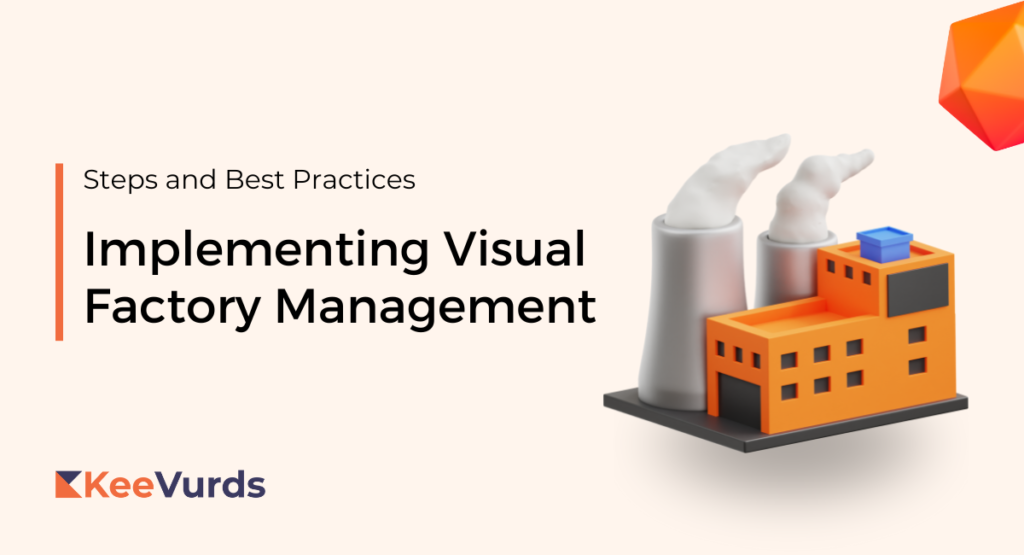Visual Factory Management is a systematic approach that utilizes visual tools and techniques to improve efficiency, enhance communication, and streamline operations in organizations.
By leveraging visual displays, cues, and communication plans, Visual Factory Management enables better control over processes, reduces errors, and fosters employee engagement.
In this blog, we will explore the steps and best practices for implementing Visual Factory Management and the significant benefits it provides to organizations.
Introduction to Visual Factory Management
Visual Factory Management is a methodology that focuses on making information and processes visually accessible to employees. It aims to make the workplace more transparent by using visual tools such as signs, charts, and color-coded displays to communicate information effectively.
The purpose is to create an environment where everyone can easily understand and interpret information, leading to improved decision-making and productivity.
Implementing Visual Factory Management can have a profound impact on organizations. It improves operational efficiency by making information readily available, thereby reducing time wasted on searching for critical data.
Additionally, Visual Factory Management enhances employee engagement as it encourages active participation and promotes a culture of continuous improvement. It also strengthens communication and collaboration among team members, fostering a more cohesive and productive work environment.
Benefits of Visual Factory Management
Improved efficiency and productivity
Visual Factory Management increases efficiency by providing employees with clear instructions and visual cues, eliminating the need for excessive written documentation and reducing the chance of errors.
By simplifying processes and reducing the time spent searching for information, employees can focus on value-added tasks, improving productivity significantly.
Enhanced employee engagement and communication
Visual Factory Management engages employees by making information easily accessible and understandable. With visual displays and cues, employees can quickly grasp key information, understand goals, and monitor progress.
This promotes a sense of ownership and accountability, leading to increased engagement and motivation. Furthermore, visual communication tools facilitate effective communication between team members, departments, and shifts, leading to better collaboration.
Better quality control and mistake prevention
Visual Factory Management enables organizations to implement robust quality control measures. By visually representing performance metrics and quality standards, employees can easily identify deviations and take immediate corrective actions. This proactive approach helps prevent mistakes, reduces rework, and improves overall product quality.
Steps to Implement Visual Factory Management
Step 1: Assess the current state
Before implementing Visual Factory Management, it is crucial to assess the current state of the organization. Identify processes and areas that can benefit from visual management and determine the goals and objectives of implementing visual management.
Evaluate different aspects of the organization, such as production lines, inventory management, and quality control, to identify areas where visual management can be implemented effectively.
Clearly define the goals and objectives you aim to achieve with Visual Factory Management. Whether it is improving efficiency, reducing errors, or increasing employee engagement, establishing clear objectives will guide the implementation process.
Step 2: Design visual management systems
Once the current state assessment is complete, the next step is to design visual management systems tailored to your organization’s needs.
Select appropriate visual tools and techniques:
Choose visual tools and techniques that align with your goals and objectives. This may include visual signs, charts, graphs, kanban boards, or digital displays.
Create visual displays and cues for important information and metrics:
Develop visual displays and cues that convey information clearly and succinctly. Ensure that they are prominently displayed in relevant areas for easy visibility.
Develop a visual communication plan for employees:
Establish a communication plan to educate employees on the purpose, benefits, and usage of visual management tools. It is vital to ensure that everyone understands the visual language and its significance.
Step 3: Train and engage employees
As Visual Factory Management relies on active employee involvement, it is essential to provide training and engage employees throughout the process.
Educate employees on the purpose and benefits of visual management:
Conduct training sessions to explain the concept, purpose, and benefits of visual management. Emphasize how it can improve their work and contribute to the organization’s success.
Provide training on how to use visual tools and systems effectively:
Guide employees on how to effectively use the selected visual tools and systems. Demonstrate how to interpret visual displays, track performance, and identify areas for improvement.
Encourage employee participation and feedback in the visual management process:
Foster a culture of employee participation and ownership by encouraging feedback, suggestions, and ideas for improving the visual management systems. Actively involve employees in creating and updating visual displays to promote engagement and continuous improvement.
Step 4: Implement and monitor visual factory management
After designing and training, it is time to implement visual management systems and monitor their effectiveness.
Execute the visual management plan across the organization:
Roll out the visual factory management software across the organization, ensuring that they are consistently implemented in all relevant areas. Communicate the expectations and benefits to employees to ensure buy-in and adoption.
Regularly review and update visual displays and cues as needed:
Visual displays should be dynamic and reflective of the current state of operations. Regularly review and update the visual displays to ensure they remain relevant and accurate. Incorporate feedback from employees and stakeholders to drive continuous improvement.
Use performance metrics to track the effectiveness of visual management:
Establish performance metrics to assess the impact of visual management on key performance indicators. Monitor these metrics to track progress, identify areas for improvement, and celebrate successes.
Best Practices for Visual Factory Management
Visual displays should convey information efficiently, avoiding clutter or unnecessary complexity. Use clear and concise messages, legible fonts, and appropriate colors to ensure easy comprehension.
Establish a set of standardized visual cues and symbols for consistency throughout the organization. This ensures that employees can interpret displays accurately, regardless of the location or department.
Visual displays should be regularly reviewed to ensure they remain relevant to the current state of the organization. Update them as necessary to reflect changing objectives, priorities, or process improvements.
Visual Factory Management should be embraced as an opportunity for continuous improvement. Encourage employees to provide feedback, suggest improvements, and actively participate in the visual management process. This cultivates a culture of continuous improvement and ownership.
Continuously offer support and training to employees, especially new team members, to ensure they are well-versed in using visual management tools. This helps maintain consistency and proficiency in utilizing visual displays and cues.
Conclusion
Summarize the key steps and best practices covered in the blog, emphasizing the importance of assessing the current state, designing visual management systems, training and engaging employees, and monitoring progress.
Reinforce the significant benefits of implementing visual factory management software like LineView, including improved efficiency, enhanced employee engagement, and better quality control. Acknowledge that there may be challenges during the implementation process and emphasize the importance of a strong communication plan and ongoing support.
Conclude by encouraging readers to consider implementing Visual Factory Management in their organization. Emphasize the potential positive impact on operational efficiency, employee engagement, and overall success. Provide resources or next steps for readers to further explore the topic and initiate their Visual Factory Management journey.
By following these steps and best practices, organizations can effectively implement Visual Factory Management, leading to improved efficiency, employee engagement, and overall operational excellence.
Start integrating Visual Factory Management into your organization, and experience the transformative power it holds in optimizing your processes and achieving sustainable success.





